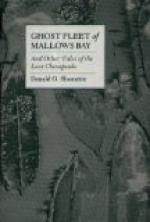Such a singular and improbable story attracted great local attention, and in 1870, Francis Vincent, publishing his “History of Delaware,” wrote: “The author found this incident in both Lednum and Foot, and has seen a copy of this painting. It is in the possession of James R. Oldham, Esq., of Christiana Bridge, the only male descendant of Herman in Delaware State. He is the seventh in descent from Augustin Herman.”—Page 469.
In 1875, Rev. Charles P. Mallery, of Chesapeake City, a part of the Bohemia Manor, wrote in the Elkton (Md.) Democrat as follows: “Herman resided on the Manor for more than twenty years, during which time he once rode to New York on the back of his favorite horse, to reclaim his long-neglected possessions there. He found his land occupied by squatters.... They secured him, as they thought, for the night; but he soon found means to escape by leaping his horse through a forced opening, swimming the North River, and continuing his flight through New Jersey until he reached the shore opposite Newcastle, where he swam his horse across the Delaware and was safe.... Dr. Spotswood, of Newcastle, told me that there was a tradition in his town that the horse was buried there.” Augustin Herman made the first drawing of New Amsterdam, and early maps of Maryland and New England. He was the first speculator in city real estate in America.
[Footnote 1: The Bohemia Manor is a tract of 18,000 acres of the best land on the Delaware peninsula. It was granted to Augustine Herman, Bohemian, whose tombstone, now lying in the yard of Richard Bayard, on the site of Herman’s park, bears date 1661. He received the manor for making an early map of Maryland, and granted a part of the land to the sect of Labadists. In the course of a century it became the homestead of Senator Richard Bassett, heir of the last lord of the manor, and of his son-in-law, Senator James A. Bayard, the first. Herman was the principal historic personage about the head of the Chesapeake, and was Peter Stuyvesant’s diplomatist to New England as well as Maryland. The argument he made for the priority of the Dutch settlement on the Delaware was the basis of the independence of Delaware State. The legend of his escape from New York is told in several local books and newspapers, and it was the subject of one of his paintings, as he was both draughtsman and designer. G. A. T.]
In 1876 I visited the relics of Herman on the Manor, and observed the topography and foliage. I then undertook to put this legend into verse, but struck a short, ill-accommodating stanza, in which I nevertheless persevered until the tale was told. I found that Herman had bought, in 1652, “the Raritan Great Meadows and the territory along the Staten Island Kills from Ompoge, or Amboy, to the Pechciesse Creek, and a tract on the south side of the Raritan, opposite Staten Island” (see Broadhead, page 537). It at once occurred to me to put the seat of Herman’s capture by squatters on this property, and to take Staten Island’s bold scenery as a contrast to that of the head of the Chesapeake, whence Herman had ridden. He could, besides, more reasonably swim the Kills than the North River with a horse, as a gentle prelude to swimming the Delaware.




